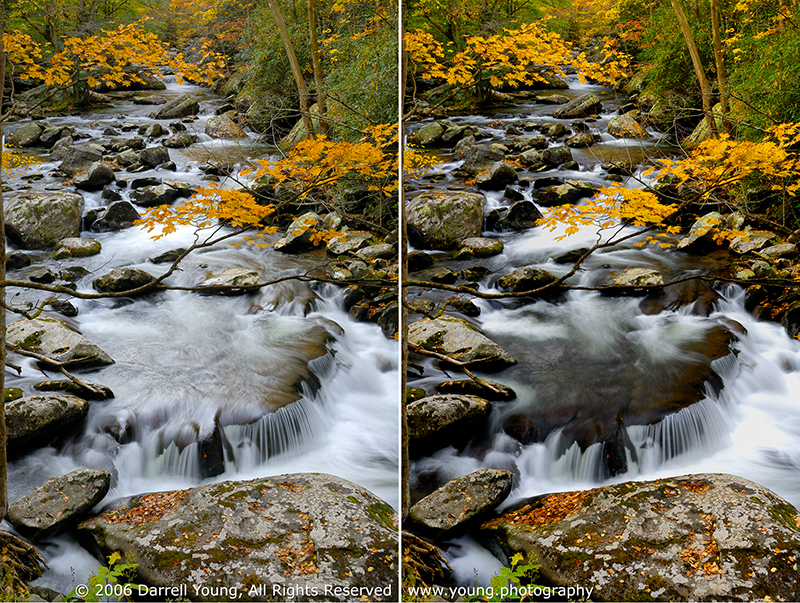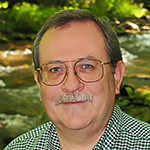Here is why nature shooters use a circular polarizer filter. The image on the left is without polarization, the one on the right is polarized. See how polarization removes the reflections from the water and even the foliage, making the colors more saturated. If you want to shoot nature, use a circular polarizer for best results.
In the two pictures you will note that there is no direct sun anywhere. I shot these two images on an overcast day to lower contrast. Many people think that a polarizer does not work unless you have the sun in the sky. That is not true, as evidenced by my images. In fact, any time there is directional light—such as the overcast light shining down through the trees in this scene—a polarizer will work to remove reflections and saturate the colors.
One thing to be cautious about is to make sure that you are using a “circular polarizer” (abbreviations on filter ring of CIR PL or CPL) and not an older linear polarizer. The older liner types can interfere with the autofocus system on a newer DSLR. Circular polarizers do not interfere with AF.
Also, be aware that a polarizer reduces the amount of light by from 1.5 to 2 stops because it allows only the transmission of light that is vibrating in one direction, meaning that extra exposure is required. Of course, your camera will compensate for the light loss and still make a good exposure. However, you may be limited to using a tripod when the light is dim due to slower shutter speeds.
Using a circular polarizer is a mainstay of nature photographers everywhere. My pictures show why. If you haven’t used one yet, now’s the time to try.
Keep on capturing time…
Darrell Young
Darrell Young is an active member of the Nikonians User Community, Nikon Professional Services (NPS), Professional Photographers of America (PPA), North American Nature Photography Association (NANPA), and the author of 18 photography books from NikoniansPress and Picture and Pen Press, through Rocky Nook. You may review a few of Darrell’s books here. He has been an avid photographer since 1968 when his mother gave him a Brownie Hawkeye camera. Here is one of Darrell’s nature image portfolios.
His website, www.PictureAndPen.com, was created to support the readers of his educational books, photography students, and clients. Visitors to his website will find articles and reviews designed to inform, teach, and help you enjoy your photographic journey.


Hey Darrell … I think your articles for Nikon are great … you might want to consider adding a twitter / fb button. I for one would be happy to promote for you … getting more traffic is always good!! ; ))
LOVE your insight!
I never realized a polarizer made such a big difference. Definitely getting one ASAP! Fall’s coming which is my favorite time of year for shooting outdoors 🙂
I’m new in the DSLR format, ( I love film camera’s, postive film). Your book on the Nikon D300 has help me tremendously. Thank you Darrell for your insights on the various Nikon camera’s. I enjoy reading all what you have to say. Very well done!
I keep a 16mp Coolpix that I carry for quick and sample shots, and for places I don’t want to carry my good camera. I was on a sandy beach in Fla. watching the sunset and tried a couple of shots which came out with a lot of glare. I took off my Polarized sun glasses an held them over the lens and took some shots, the pictures came out with much more details and very little glare. Have been a fan of polarized filters for many years but had not thought of that trick before.